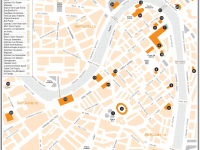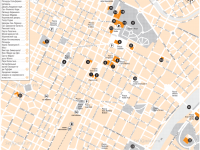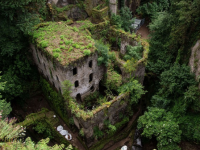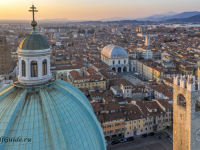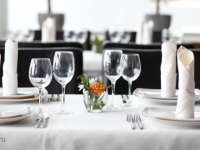Главная > Италия > Регион Кампания > Неаполь > Туристические маршруты по Неаполю
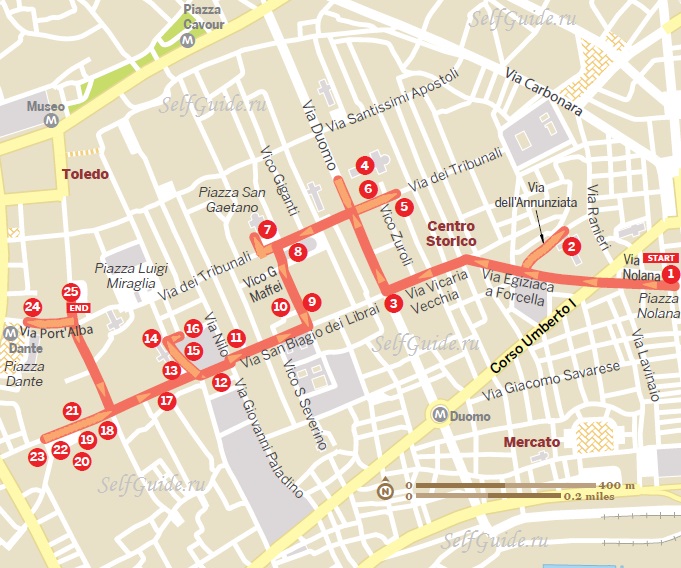
START PORTA NOLANA
END PIAZZA BELLINI
LENGTH 3KM; FOUR HOURS
Bustling for over 2000 years, Naples’ centro historico (historic centre) is a rumbling mass of contradictions. Hyperactive streets sit atop silent ruins, crumbling facades mask mighty baroque interiors, and cultish shrines flank hedonistic bars. No other part of the city intrigues or intoxicates so intensely, and none offers such a density of artistic and architectural treasures.
Begin your walk at 15th-century city gate 1Porta Nolana, its exterior wall featuring a marble relief of Ferdinand I, illegitimate son of Alfonso V of Aragon (who was also king of Naples from 1458 to 1494). On the other side of the gate is a 17th-century bust of San Gaetano. These days, Porta Nolana is better known as the gateway to the Mercato di Porta Nolana.
After exploring the market, head west along Via Nolana. Cross Corso Umberto I, head right into Via Egiziaca a Forcella and then right again into Via dell’Annunziata. A little way down on your right you’ll see the 2Santissima Annunziata, famous for its orphanage and ruota, the wooden wheel where babies were once abandoned. Head back to Via Egiziaca a Forcella and turn right into it. After crossing Via Pietro Colletta, follow the street as it veers left and merges into Via Vicaria Vecchia. Where it meets Via Duomo stands one of Naples’ oldest churches, the 3Basilica di San Giorgio Maggiore. Built by St Severus in the 4th century but thoroughly restyled by Cosimo Fanzago in the mid-17th century, its original Palaeo-Christian apse is now part of the main entrance. Two blocks northwest up Via Duomo soars Naples’ impressive cathedral, the 4Duomo (p55).
Double back down Via Duomo until you meet Via dei Tribunali. Known to the Romans as the decumanus maior (main road), this street runs parallel to the decumanus inferior, aka Spaccanapoli, aka Via San Biagio dei Librai. Before heading right into the heart of the centro storico, nip left to admire Caravaggio’s masterpiece Le Sette Opere di Misericordia (The Seven Acts of Mercy) in the 5Pio Monte della Misericordia (p55). Soaring from the small square opposite is the 6Guglia di San Gennaro.
After you’ve crossed Via Duomo make for Piazza San Gaetano, about 150m down on the right. The tiny square where the Roman forum once stood is now dominated by the imposing 7Basilica di San Paolo Maggiore, whose sumptuous baroque sacristy is one of the city’s hidden delights. Opposite the piazza is the 8Complesso Monumentale di San
Lorenzo Maggiore (p54), its stark but beautiful Gothic basilica sitting atop evocative Roman scavi (excavations). Take a peek before heading down 9Via San Gregorio Armeno – in December people come from all over Italy to visit the presepi (nativity scene) shops that line this street. Also here is the rococo aChiesa e Chiostro di San Gregorio Armeno.
At the end of the road you hit Via San Biagio dei Librai. Turn right and after about 250m you’ll be on bPiazzetta Nilo, home to the ancient Statua del Nilo and (less imposingly) the altar to footballer Maradona inside Bar Nilo. Further down on the left, the cChiesa di Sant’Angelo a Nilo is home to an exquisite tomb.
From here it’s only a few steps to handsome dPiazza San Domenico Maggiore, location of the imposing eChiesa di San Domenico Maggiore. At No 9 stands the notorious fPalazzo dei Di Sangro, where composer Carlo Gesualdo brutally murdered his wife and her lover. Around the corner from the palazzo is Via Francesco de Sanctis, where you’ll find the not-to-be-missed gCappella Sansevero (p54), home to the mesmerising Cristo velato (Veiled Christ).
As you walk west on Via San Biagio dei Librai it becomes Via Benedetto Croce. On the left, at No 45, stands hPalazzo Carafa della Spina, designed by Domenico Fontana in the late 16th century and revamped in the first half of the 18th century. Its baroque portone (entrance) is one of Naples’ finest. Further west is the iBasilica di Santa Chiara (p54), meticulously reconstructed after heavy bomb damage in WWII. Nearby jPiazza del Gesù Nuovo is home to nightly revelry and, at No 14, kLibreria Dante & Descartes, an erudite bookshop. Dominating the piazza’s northern side is the glorious lChiesa del Gesù Nuovo, while at its centre is the mGuglia dell’Immacolata, created between 1747 and 1750; the gilded copper statue of the Virgin Mary was added in 1753.
Cinephiles may recognise the central balcony of nPalazzo Pandola, at No 33, from the closing scene of Vittorio de Sica’s Matrimonio all’italiana (Marriage, Italian Style), starring Sophia Loren and Marcello Mastroianni. Backtrack from the square, turning left into Via San Sebastiano. At the next intersection on your left, bookshop-lined Via Port’Alba leads down to oPort’Alba, a city gate built in 1625 that leads into Piazza Dante.
Double back the way you came, turn left back into Via San Sebastiano, and a block ahead on your right is p Piazza Bellini and its restorative cafes.
Главная > Италия > Регион Кампания > Неаполь > Туристические маршруты по Неаполю
